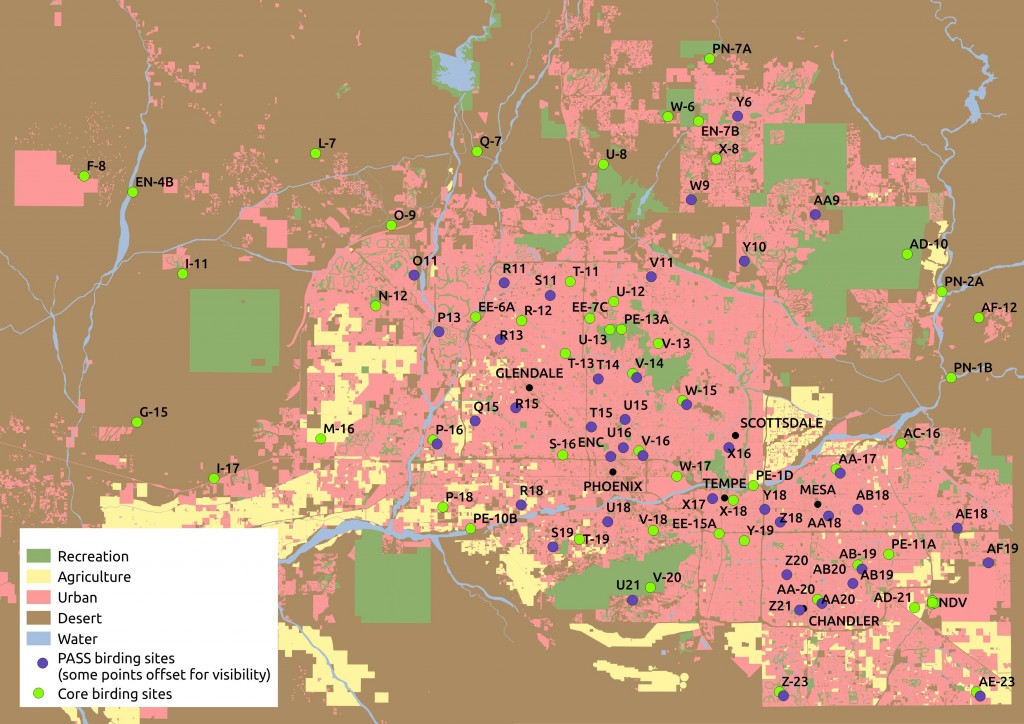Bird Censuses

Over the past half-century, the greater Phoenix metropolitan area has been one of the fastest growing regions in the US, experiencing rapid urban expansion in addition to urban intensification. This backdrop provides an ideal setting to monitor biodiversity changes in response to urbanization, and the CAP LTER has been using a standardized point-count protocol to monitor the bird population in the greater Phoenix metropolitan area and surrounding Sonoran desert region since 2000. The point count locations span a diversity of habitats including urban, suburban, rural, industrial areas, parks, agricultural fields, and native Sonoran desert. Many monitoring locations are co-located with other CAP LTER long-term monitoring programs, such as the Ecological Survey of Central Arizona, ground-dwelling arthropod monitoring, and Salt River Biodiversity, allowing investigators to leverage data from multiple monitoring efforts. Censuses are conducted in the winter and spring to capture the bird community at the peaks of activity, and each birding location is visited by three different professional birders each season who identify all birds seen and heard in the sampling radius.
Datasets
- Point-count bird censusing: long-term monitoring of bird abundance and diversity in central Arizona-Phoenix, ongoing since 2000
- Point-count bird censusing: bird abundance and diversity in CAP LTER Phoenix Area Social Survey neighborhoods throughout the greater Phoenix metropolitan area, 2006-2016
- Point-count bird censusing: long-term monitoring of bird abundance and diversity along the Salt River in the greater Phoenix metropolitan area, ongoing since 2013
- Bird surveys along the Salt River in and near the greater Phoenix metropolitan area: 2012-2013
- Vegetation surveys at CAP LTER ripirain-area bird-monitoring locations in the greater Phoenix metropolitan area (2013)
Publications
Warren, P. S., S. B. Lerman, R. Andrade, K. L. Larson and H. L. Bateman. 2019. The more things change: Species losses detected in Phoenix despite stability in bird–socioeconomic relationships. Ecosphere 10(3):e02624. DOI: 10.1002/ecs2.2624. (link )
Allen, D. C., H. L. Bateman, P. S. Warren, F. Suzart de Albuquerque, S. Arnett-Romero and B. Harding. 2019. Long-term effects of land-use change on bird communities depend on spatial scale and land-use type. Ecosphere 10(11):e02952. DOI: 10.1002/ecs2.2952. (link )
Banville, M. J., H. L. Bateman, S. R. Earl and P. S. Warren. 2017. Decadal declines in bird abundance and diversity in urban riparian zones. Landscape and Urban Planning 159(Mar):48-61. DOI: 10.1016/j.landurbplan.2016.09.026. (link )
Lerman, S. B., V. K. Turner and C. Bang. 2012. Homeowner associations as a vehicle for promoting native urban biodiversity. Ecology and Society 17(4):Art. 45. (link )
Lerman, S. B. and P. S. Warren. 2011. The conservation value of residential yards: Linking birds and people. Ecological Applications 21(4):1327-1339. (link )
Shochat, E., S. B. Lerman, J. M. Anderies, P. S. Warren, S. H. Faeth and C. H. Nilon. 2010. Invasion, competition, and biodiversity loss in urban ecosystems. BioScience 60(3):199-208. DOI: 10.1525/bio.2010.60.3.6. (link )
Walker, J. S. and E. Shochat. 2010. Scalar effects of vegetation on bird communities in an urbanizing desert ecosystem. Urban Ecosystems 13:155-167. DOI: 10.1007/s11252-009-0112-0. (link )
Walker, J. S., R. C. Balling, J. M. Briggs, M. V. Katti, P. S. Warren and E. A. Wentz. 2008. Birds of a feather: Interpolating distribution patterns of urban birds. Computers, Environment and Urban Systems 32(1):19-28. DOI: 10.1016/j.compenvurbsys.2007.02.001. (link )

